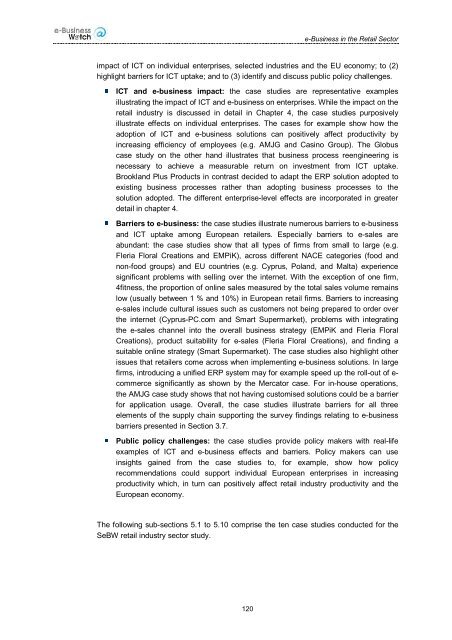ICT and e-Business Impact in the Retail Industry - empirica
ICT and e-Business Impact in the Retail Industry - empirica
ICT and e-Business Impact in the Retail Industry - empirica
- No tags were found...
Create successful ePaper yourself
Turn your PDF publications into a flip-book with our unique Google optimized e-Paper software.
e-<strong>Bus<strong>in</strong>ess</strong> <strong>in</strong> <strong>the</strong> <strong>Retail</strong> Sectorimpact of <strong>ICT</strong> on <strong>in</strong>dividual enterprises, selected <strong>in</strong>dustries <strong>and</strong> <strong>the</strong> EU economy; to (2)highlight barriers for <strong>ICT</strong> uptake; <strong>and</strong> to (3) identify <strong>and</strong> discuss public policy challenges.<strong>ICT</strong> <strong>and</strong> e-bus<strong>in</strong>ess impact: <strong>the</strong> case studies are representative examplesillustrat<strong>in</strong>g <strong>the</strong> impact of <strong>ICT</strong> <strong>and</strong> e-bus<strong>in</strong>ess on enterprises. While <strong>the</strong> impact on <strong>the</strong>retail <strong>in</strong>dustry is discussed <strong>in</strong> detail <strong>in</strong> Chapter 4, <strong>the</strong> case studies purposivelyillustrate effects on <strong>in</strong>dividual enterprises. The cases for example show how <strong>the</strong>adoption of <strong>ICT</strong> <strong>and</strong> e-bus<strong>in</strong>ess solutions can positively affect productivity by<strong>in</strong>creas<strong>in</strong>g efficiency of employees (e.g. AMJG <strong>and</strong> Cas<strong>in</strong>o Group). The Globuscase study on <strong>the</strong> o<strong>the</strong>r h<strong>and</strong> illustrates that bus<strong>in</strong>ess process reeng<strong>in</strong>eer<strong>in</strong>g isnecessary to achieve a measurable return on <strong>in</strong>vestment from <strong>ICT</strong> uptake.Brookl<strong>and</strong> Plus Products <strong>in</strong> contrast decided to adapt <strong>the</strong> ERP solution adopted toexist<strong>in</strong>g bus<strong>in</strong>ess processes ra<strong>the</strong>r than adopt<strong>in</strong>g bus<strong>in</strong>ess processes to <strong>the</strong>solution adopted. The different enterprise-level effects are <strong>in</strong>corporated <strong>in</strong> greaterdetail <strong>in</strong> chapter 4.Barriers to e-bus<strong>in</strong>ess: <strong>the</strong> case studies illustrate numerous barriers to e-bus<strong>in</strong>ess<strong>and</strong> <strong>ICT</strong> uptake among European retailers. Especially barriers to e-sales areabundant: <strong>the</strong> case studies show that all types of firms from small to large (e.g.Fleria Floral Creations <strong>and</strong> EMPiK), across different NACE categories (food <strong>and</strong>non-food groups) <strong>and</strong> EU countries (e.g. Cyprus, Pol<strong>and</strong>, <strong>and</strong> Malta) experiencesignificant problems with sell<strong>in</strong>g over <strong>the</strong> <strong>in</strong>ternet. With <strong>the</strong> exception of one firm,4fitness, <strong>the</strong> proportion of onl<strong>in</strong>e sales measured by <strong>the</strong> total sales volume rema<strong>in</strong>slow (usually between 1 % <strong>and</strong> 10%) <strong>in</strong> European retail firms. Barriers to <strong>in</strong>creas<strong>in</strong>ge-sales <strong>in</strong>clude cultural issues such as customers not be<strong>in</strong>g prepared to order over<strong>the</strong> <strong>in</strong>ternet (Cyprus-PC.com <strong>and</strong> Smart Supermarket), problems with <strong>in</strong>tegrat<strong>in</strong>g<strong>the</strong> e-sales channel <strong>in</strong>to <strong>the</strong> overall bus<strong>in</strong>ess strategy (EMPiK <strong>and</strong> Fleria FloralCreations), product suitability for e-sales (Fleria Floral Creations), <strong>and</strong> f<strong>in</strong>d<strong>in</strong>g asuitable onl<strong>in</strong>e strategy (Smart Supermarket). The case studies also highlight o<strong>the</strong>rissues that retailers come across when implement<strong>in</strong>g e-bus<strong>in</strong>ess solutions. In largefirms, <strong>in</strong>troduc<strong>in</strong>g a unified ERP system may for example speed up <strong>the</strong> roll-out of e-commerce significantly as shown by <strong>the</strong> Mercator case. For <strong>in</strong>-house operations,<strong>the</strong> AMJG case study shows that not hav<strong>in</strong>g customised solutions could be a barrierfor application usage. Overall, <strong>the</strong> case studies illustrate barriers for all threeelements of <strong>the</strong> supply cha<strong>in</strong> support<strong>in</strong>g <strong>the</strong> survey f<strong>in</strong>d<strong>in</strong>gs relat<strong>in</strong>g to e-bus<strong>in</strong>essbarriers presented <strong>in</strong> Section 3.7.Public policy challenges: <strong>the</strong> case studies provide policy makers with real-lifeexamples of <strong>ICT</strong> <strong>and</strong> e-bus<strong>in</strong>ess effects <strong>and</strong> barriers. Policy makers can use<strong>in</strong>sights ga<strong>in</strong>ed from <strong>the</strong> case studies to, for example, show how policyrecommendations could support <strong>in</strong>dividual European enterprises <strong>in</strong> <strong>in</strong>creas<strong>in</strong>gproductivity which, <strong>in</strong> turn can positively affect retail <strong>in</strong>dustry productivity <strong>and</strong> <strong>the</strong>European economy.The follow<strong>in</strong>g sub-sections 5.1 to 5.10 comprise <strong>the</strong> ten case studies conducted for <strong>the</strong>SeBW retail <strong>in</strong>dustry sector study.120
















